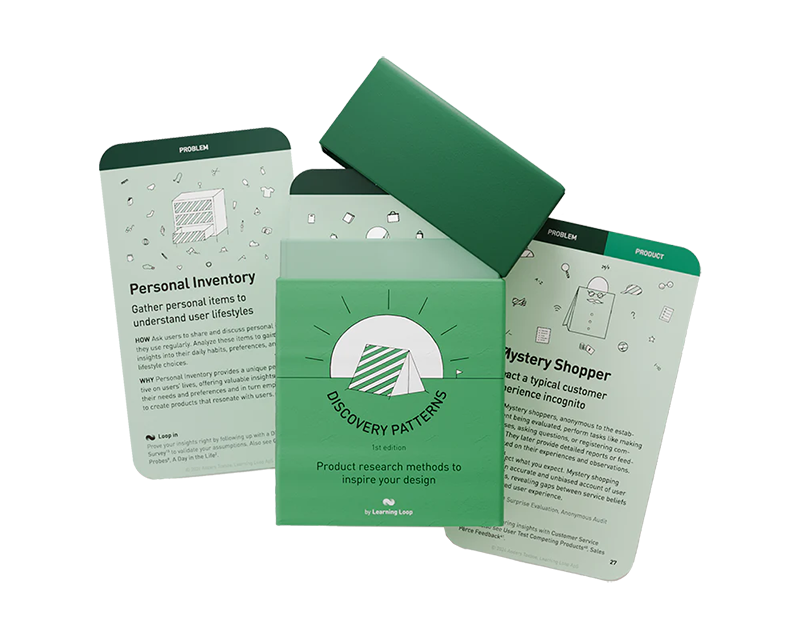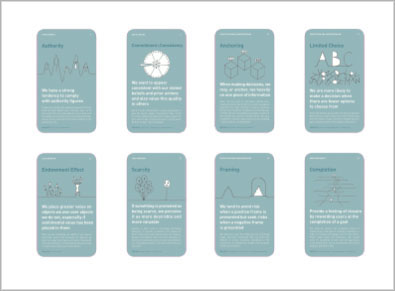
How: Conduct role-playing sessions where team members act out scenarios using the product. This simulates real user interactions, helping identify potential issues and improvements.
Why: Engaging in role-playing enables designers to better understand their users by immersing themselves in their perspectives and challenges. By simulating user scenarios, designers can gain valuable insights into unaddressed needs and enhance their empathetic connection with users.
Role playing is a generative research method used in product discovery to simulate real-world use and explore potential interactions from the user’s perspective. Rooted in theatre, psychology, and education, role playing allows teams to immerse themselves in imagined but plausible user experiences. The goal is not to gather statistically significant data, but to generate empathy, uncover micromoments of friction or delight, and prompt creative leaps in problem-solving. It’s a tool for seeing your product not as a system of features, but as a participant in the user’s life.
This technique can be used early in the design process when concepts are still malleable, or later on to test and refine detailed interactions. It works across digital, service, and physical products. Role playing offers a safe environment to explore failure modes, challenge assumptions, and rehearse outcomes that would be hard or risky to stage in the real world.
Why Role Playing works for product design
At the heart of role playing is the concept of perspective-taking. When teams step into the shoes of a persona or act out a user journey, they experience the product as a participant rather than as a builder. This break from the builder mindset helps identify gaps in understanding, assumptions that don’t hold, and subtle cues in behavior that often get flattened in spreadsheets or post-its.
Role playing is also uniquely suited for uncovering micromoments—those small but meaningful interactions that make or break user experience. As highlighted in Stephen P. Anderson’s “UX Design, Role-playing & Micromoments,” the nuance of conversation between user and interface becomes much more tangible when enacted, especially when someone “plays the interface.” This kind of embodied simulation helps surface inconsistencies, ambiguities, or emotional reactions that static wireframes don’t reveal.
Moreover, role play is an accessible way to explore user-centered design in a collaborative setting. It engages not only researchers and designers, but engineers, product managers, marketers, and even stakeholders. It democratizes insight by making the user journey visible and felt in the room.
Role playing can also surface accessibility barriers and inclusion gaps that are difficult to anticipate through conventional methods. By embodying scenarios where a user has limited mobility, sensory impairment, or cultural constraints, teams can better understand where systems exclude, frustrate, or overwhelm. These exercises are not meant to replicate lived experiences but to create awareness and humility in the design process.
Role playing is particularly powerful in:
- Revealing emotional friction or delight that users may not articulate in interviews.
- Exploring how a product might be misused or misunderstood.
- Testing team alignment on user needs and use case assumptions.
- Surfacing tacit knowledge and decision-making heuristics in complex workflows.
- Assessing inclusivity and how design decisions impact users with accessibility needs.
“You don’t always know what a design problem feels like until you pretend to be someone struggling with it.”
That emotional recognition is where breakthrough insights emerge.
It is well-suited for early-stage ideation, service blueprinting, accessibility scenarios, onboarding journey validation, or any moment where empathy and creativity are critical.
Conducting a Role Playing session
Role playing sessions typically follow five structured phases: definition, warm-up, playing, finalization, and evaluation. During the definition phase, facilitators define goals, choose the type of scenario to explore, and clarify what roles participants will take on. Scenarios can range from typical user flows to edge cases or breakdowns. Personas—complete with backstories and motivations—ground the exercise in realistic behavior.
The warm-up phase helps participants get comfortable with the exercise. A simple improv activity or physical movement can lower social barriers and encourage imaginative participation. During the playing phase, participants act out the scenario in real-time. One might be the user, another the interface or system, and others might observe.
Here, facilitators must choose between scripted vs. improvised play. Scripted role play offers structure, helpful when consistency or repeatability is needed. Improvised play, however, can reveal more authentic reactions and behavioral patterns. The choice depends on the maturity of the idea and the purpose of the session.
Finalization transitions participants out of their roles, giving them space to debrief emotionally. The evaluation phase focuses on documenting observations, insights, surprises, and open questions. In this phase, video recordings, observer notes, or direct transcripts can be synthesized into patterns or next steps for design iterations.
Practical formats and variants
There are different types of role playing formats used across UX workshops and product discovery:
- System role-play: Participants act as parts of a system (e.g., interface, backend, user) to uncover interaction bottlenecks.
- Perspective role-play: Participants assume mental roles such as the “optimist,” “pessimist,” or “privacy critic” to interrogate assumptions.
- Interface simulation: A team member acts as the UI, responding to user inputs in real time based on scripted or prototype prompts.
- Live persona acting: One participant inhabits a persona and responds authentically to prompts, surfacing emotional or cognitive responses.
- Design game role play: Used early in concept development to test how a future product or service might fit into daily routines.
Each format can be tuned to match the fidelity of your ideas and the depth of feedback you need.
Getting it right
Role playing isn’t about performance—it’s about insight.
You’re not looking for Oscar-worthy acting, but genuine reactions.
You’re not looking for Oscar-worthy acting, but genuine reactions. The goal is behavioral discovery, not acting perfection. Participants should focus on what the user might do, not how well they play a role.
Facilitators should anticipate discomfort, especially for participants unfamiliar with acting. Light warm-ups and a supportive environment help reduce resistance.
Bias is another consideration. Participants may unintentionally project their own preferences instead of embodying the user’s mindset. Mitigation strategies include grounding roles in research-based personas and observing behavior rather than assuming intention.
Finally, role playing should not replace direct user contact. It complements user interviews and usability testing by simulating contexts that are hard to observe or by testing new ideas before prototypes exist.
Preparing for Role Playing
Preparation depends on the goals and fidelity of the session. For early explorations, you might only need post-its, index cards, and a shared understanding of the personas. For higher-fidelity exercises, bring in printed screens, props, scripts, or even costume pieces to mark role transitions. Physical space matters too—a cleared area helps movement, and changing the room layout can signal that it’s okay to act differently.
Start with a clear scenario. “A first-time user signs up for our app and hits a blocker on the welcome screen” is better than “let’s role-play onboarding.” Invite observers to take notes on user behavior, emotional cues, and breakdowns. And always reserve time to reflect: What surprised us? What would we change based on this interaction? What’s unclear about our product or our assumptions?
Invite people to learn by doing and feeling
Role playing invites teams to learn by doing and by feeling. It brings to light the social, emotional, and contextual realities of using a product, not just its technical performance. In doing so, it transforms abstract personas into embodied experiences and surface-level flows into lived interactions.
As a research method, it’s not meant to validate or quantify. It’s meant to challenge, expand, and spark. It’s especially valuable when paired with methods like user interviews, journey mapping, or prototyping—offering a narrative layer that connects user needs with product decisions.
It also supports cross-functional alignment. When designers, developers, and marketers role play together, they build shared empathy, language, and priorities. It’s a perfect way to get the engineering team to care about that empty state or awful error copy because they can suddenly feel how awkward it is during a role play.
Ultimately, role playing helps teams move beyond usability to usability-in-context. It is where design thinking meets rehearsal—an experiment in understanding, not just delivery.
Real life Role Playing examples
IDEO
IDEO often uses role-playing to understand user needs, especially in early design stages, leading to more user-centric and innovative product solutions.
Airbnb
Airbnb utilizes role-playing to simulate customer experiences, helping improve their platform’s usability and overall user satisfaction.
A collection of clever product discovery methods that help you get to the bottom of customer needs and coining the right problem before building solutions. They are regularly used by product builders at companies like Google, Facebook, Dropbox, and Amazon.
Get your deck!Related plays
- Role-play Exercises in User Experience-driven Product Development by Dominique Winter at ResearchGate
- UX Design, Role-playing & Micromoments by Stephen P. Anderson at Center Centre
- Foundational UX Workshop Activities by Sarah Gibbons at Nielsen Norman Group
- Design Games — Role Plays by Donna Spencer at UX Mastery
- Roleplaying and UX Research by NYC Design at Medium
- What are some ways to use role-playing for ideation in product design? at LinkedIn

